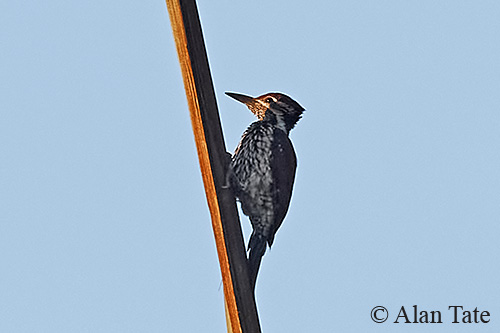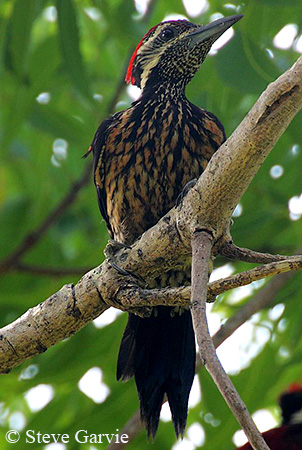
Fr: Pic de Lichtenstein
Ang: Red-backed Flameback
All: Rotrückenspecht
Esp: Pito dorsirrojo
Nd: Lichtensteins Goudrugspecht
Sd: rödryggig flamspett
Photographers:
Steve Garvie
RAINBIRDER Photo galleries
Philip Stapelberg
GALLERY
Alan & Ann Tate
AA Bird Photography
Text by Nicole Bouglouan
Sources:
HANDBOOK OF THE BIRDS OF THE WORLD Vol. 7 by Josep del Hoyo-Andrew Elliott-Jordi Sargatal – Lynx Edicions – ISBN: 8487334377
WOODPECKERS, an identification guide of the woodpeckers of the world by Winkler Hans and Christie David – Helm – ISBN: 0395720435
Woodpeckers of the World: The Complete Guide by Gerard Gorman – Editeur: A&C Black, 2014 – Helm Photographic Guides - ISBN: 1408147173, 9781408147177
Fatbirder - The World’s Richest Information Resource about Birds for Birders
CREAGUS@Monterey Bay (Don Roberson)
Wikipedia, the free encyclopaedia
Red-backed Flameback
Dinopium psarodes
Piciformes Order – Picidae Family
INTRODUCTION:
The Red-backed Flameback was formerly a subspecies of the Black-rumped Flameback (Dinopium benghalense).
It is endemic to Sri Lanka where it frequents lowland forest, wooded gardens and plantations, up to 1,500 metres of elevation. It is absent in the northern part of the island.
It feeds on a variety of invertebrates, but some fruits are also part of the diet.
It typically nests in excavated hole in tree where 2-3 eggs are laid. Both parents share the nesting duties.
The Red-backed Flameback is common to locally common throughout its restricted range, although some declines have been caused by habitat loss. But the species is not globally threatened at the moment.
DESCRIPTION OF THE BIRD:
Biometrics:
Length: 28 cm (26-29 cm)
The Red-backed Flameback adult male has black nape, hindneck and upper mantle, whereas lower mantle and back are bright scarlet. On the upperwing, the red scapulars and wing-coverts are duller. Some white terminal spots are visible on outer lesser and median coverts. The flight-feathers are brownish-black, with dull red outer webs of tertials and secondaries. We can see well-spaced white spots on primaries and inner webs of both secondaries and tertials. The trailing edge is black. Rump and uppertail-coverts are black, but some red feather tips are sometimes apparent. The stiffly pointed tail is black.
The underparts are whitish to pale buff from below the uppermost part of the breast, and heavily streaked with black, while the lowermost area may be barred black. The underwing is spotted black and white, well visible in flight.

On the head, forehead and crown are black with broad, red feather tips, and resplendent bright red crest. Nape and hindneck are black.
We can see a conspicuous white supercilium extending to the nape, underlined by a streaked black and white band extending from the eye through the ear-coverts to the hindneck.
A conspicuous white cheek band extends down neck side to side of upperbreast. The area from chin and throat to uppermost breast is black with some white spots.
The fairly long bill is blackish to grey with paler base of lower mandible. It ends in a blunt point. The culmen is curved but narrow across the nostrils.
The eyes are red-brown to reddish, surrounded by green to grey eyering.
Legs and zygodactyl feet are grey to grey-green.
The adult female has forehead and forecrown spotted black and white. The red feathers of the hind crown form a pointed crest.
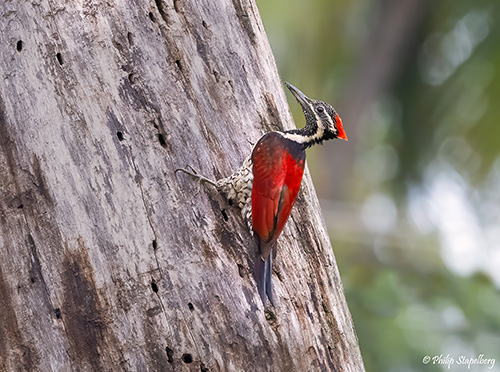
The juvenile is duller, with less pronounced markings. The black areas are browner and the underparts are greyer with darker markings.
The young male may show narrow red feather tips with sometimes white spots on the crown.
The young female has few or no spots on the crown.
The Red-backed Flameback may sometimes hybrid with Dinopium benghalense, involving a blend of red, orange or yellow plumage.
RANGE:
The Red-backed Flameback is endemic to Sri Lanka where it occurs throughout the island, except in the far-north region.
HABITAT:
The Red-backed Flameback frequents a variety of habitats such as subtropical or tropical dry forests, moist lowland forests and mangroves.
But it also can be seen in more human environments including home gardens and plantations. The species is visible up to 1,500 metres of elevation.
It is mostly found in the dry zone, although it also likes humid habitats.
CALLS AND SONGS: SOUNDS BY XENO-CANTO
The Red-backed Flameback produces a sharp, screeching, whinnying call, usually less musical than the call of Dinopium benghalense.
Other calls are described as a rhythmic “woik-woik-wi-ti-t-t-t-t-trrrrr” and also a repeated “woik-tri-tri-tri-tri-tri-tri-tri” of about 3 seconds.
This species has a dull, rapid drumming sound, wavering in volume and fading gently towards the end. It lasts between 0,8 and 1,5 seconds.
BEHAVIOUR IN THE WILD:
The Red-backed Flameback feeds primarily on ants, especially Carpenter ants (genus Camponotus) and both larvae and pupae of Asian weaver ants (Oecophylla smaragdina). But other invertebrates including spiders, caterpillars, weevils and beetles are also part of its diet. It may occasionally take fruit.
This species forages alone or in pairs, and in family groups after the breeding season. It can also be seen in mixed-species foraging flocks with other Dinopium flamebacks.
It searches for prey in trees, at all levels, clinging to the underside of the branches, with help of the stiffly pointed specialized tail feathers allowing woodpeckers to perch vertically on tree trunks.
However, it may occasionally descend to the ground while searching for ants.
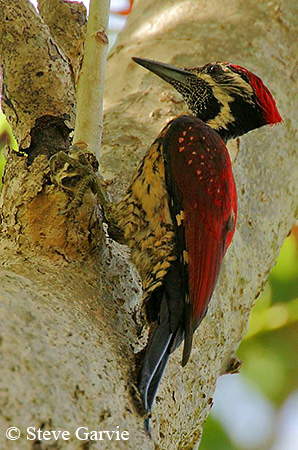
The Red-backed Flameback typically nests in cavities excavated by both mates at various heights in trees. Some courtship displays are observed, showing the male with erected crown feathers while the head is raised and the wings drooped. Courtship feeding may occur during the courtship ritual, especially in this genus.
The Red-backed Flameback is sedentary and resident breeder endemic to Sri Lanka.
Like most Picidae species, it performs an undulating flight with flap-and-glide bounding pattern.
REPRODUCTION OF THIS SPECIES:
The Red-backed Flameback may have two breeding periods, the primary from December to September, with peak in August-September, and a second one from February to June.
The species may sometimes lay two broods per season, but more often only one.
Both adults excavate the hole in tree, at various heights. The entrance is pear-shaped and the nest-chamber is lined with wood ships.
The female lays 2-3 white eggs, and both adults incubate during 11-15 days, the male mainly at night. Both parents feed and rear the chicks.
No more information.
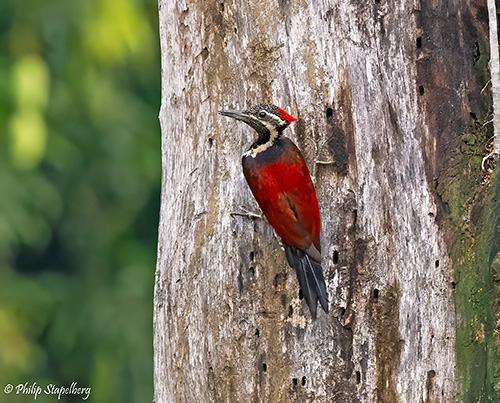
PROTECTION / THREATS / STATUS:
The Red-backed Flameback is described as common to locally common throughout its restricted range.
The size of the population is unknown, but it is suspected to be declining due to forest clearance. However, the species is not globally threatened at the moment.
The Red-backed Flameback is currently evaluated as Least Concern.
